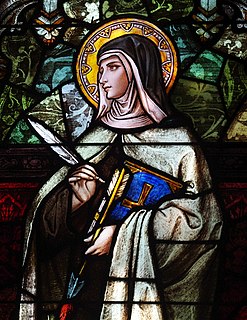Life
Among the scant information about his life, it is known that in 679 he organized and held a synod with his suffragan bishops in Milan in order to condemn the Monothelite doctrine. [1] According to Paul the Deacon this synod issued a letter, written by a Damian later bishop of Pavia, directly to Emperor Constantine IV. [2] A year later Mansuetus and his suffragan bishops participated in Rome to a synod opened by Pope Agatho on 27 march 680 and subscribed the acts there issued. This 680 Rome synod was held in preparation of the Third Council of Constantinople, which a few months later condemned the Monothelitism.

A synod is a council of a church, usually convened to decide an issue of doctrine, administration or application. The word synod comes from the Greek σύνοδος (sýnodos) meaning "assembly" or "meeting", and it is synonymous with the Latin word concilium meaning "council". Originally, synods were meetings of bishops, and the word is still used in that sense in Catholicism, Oriental Orthodoxy and Eastern Orthodoxy. In modern usage, the word often refers to the governing body of a particular church, whether its members are meeting or not. It is also sometimes used to refer to a church that is governed by a synod.
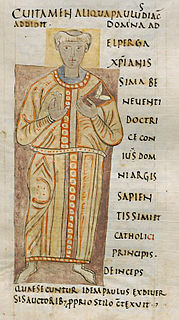
Paul the Deacon, also known as Paulus Diaconus, Warnefridus, Barnefridus, Winfridus and sometimes suffixed Cassinensis, was a Benedictine monk, scribe, and historian of the Lombards.
Damian of Pavia was Bishop of Pavia from 680, succeeding bishop Anastasius. He mediated relations between the Lombards and the Byzantine emperors. Damian wrote a letter to emperor Constantine IV in 679 on behalf of Mansuetus, archbishop of Milan, against the doctrine of Monothelitism. This letter, in a Latin edition, is the only extant writing from the hand of Damian.
Mansuetus died on 19 February probably of 685. His remains were buried in the Basilica of Sant'Ambrogio, but were later translated to the Basilica di Santo Stefano Maggiore and again in 1987 to South transept of the Milan Cathedral. [3]

The Basilica of Sant'Ambrogio is a church in Milan, northern Italy.

Basilica di Santo Stefano Maggiore is a church in Milan, Italy. It was established in the 5th century. Originally dedicated to both Saint Zechariah and Saint Stephen, it was later dedicated to Saint Stephen only. Throughout its history, has undergone several reconstructions, expansion and restoration.

A transept is a transverse part of any building, which lies across the main body of the edifice. In churches, a transept is an area set crosswise to the nave in a cruciform ("cross-shaped") building within the Romanesque and Gothic Christian church architectural traditions. Each half of a transept is known as a semitransept.
His feast day is February 19 in the Roman Rite and September 2 in the Ambrosian Rite. [2] A late tradition, with no historical basis, associates Mansuetus with the Roman family of the Savelli.

The Roman Rite is the most widespread liturgical rite in the Catholic Church, as well as the most popular and widespread Rite in all of Christendom, and is one of the Western/Latin rites used in the Western or Latin Church. The Roman Rite gradually became the predominant rite used by the Western Church. Many local variants, not amounting to distinctive Rites, existed in the medieval manuscripts, but have been progressively reduced since the invention of printing, most notably since the reform of liturgical law in the 16th century at the behest of the Council of Trent (1545–63) and more recently following the Second Vatican Council (1962–65).

The Ambrosian Rite, also called the Milanese Rite, is a Catholic Western liturgical rite. The rite is named after Saint Ambrose, a bishop of Milan in the fourth century. The Ambrosian Rite, which differs from the Roman Rite, is used by some five million Catholics in the greater part of the Archdiocese of Milan, Italy, in some parishes of the Diocese of Como, Bergamo, Novara, Lodi and in about fifty parishes of the Diocese of Lugano, in the Canton of Ticino, Switzerland.

The Savelli were a rich and influential Roman aristocratic family who rose to prominence in the 13th century and became extinct in the main line with Giulio Savelli (1626–1712).
This page is based on this
Wikipedia article Text is available under the
CC BY-SA 4.0 license; additional terms may apply.
Images, videos and audio are available under their respective licenses.

Simplician was Bishop of Milan from 397 to 400 or 401 AD. He is honoured as a Saint in the Roman Catholic and Eastern Orthodox Churches and his feast day is August 14.

Eustorgius II was Archbishop of Milan from c. 511 to 518. He is honoured as a saint in the Catholic Church and his feast day is June 6.

Benedict was Archbishop of Milan from c. 685 to c. 732. He is honoured as a saint in the Catholic Church.
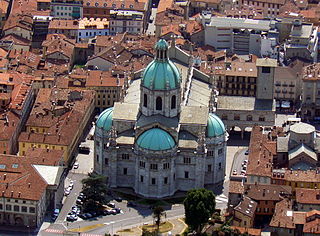
The Catholic Diocese of Como in northern Italy, has existed since the fourth century. It is a suffragan of the archdiocese of Milan. The bishops' seat is in Como Cathedral.

Alfonso Michele Litta was an Italian cardinal and the archbishop of Milan from 1652 to 1679.

Monas was Bishop of Milan from the end 3rd-century to early 4th-century. He is honoured as a Saint in the Catholic Church and his feast day is on October 12.
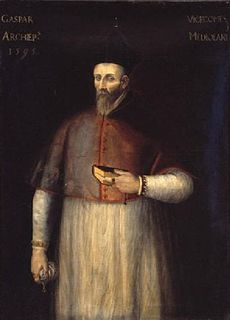
Gaspare Visconti was the Archbishop of Milan from 1584 to 1595.
The Synod of Milan or Council of Milan may refer to any of several synods which occurred in late Roman Mediolanum or medieval Milan in northern Italy's Po valley:
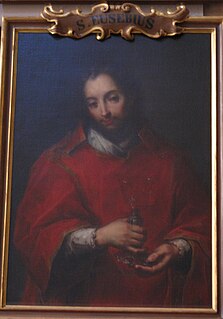
Eusebius was Archbishop of Milan from 449 to 462. He is honoured as a saint and his feast day is 12 August.
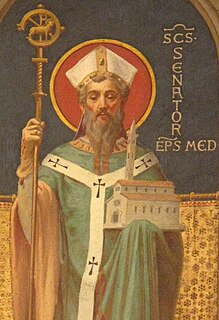
Senator of Milan or Senator of Settala was Bishop of Milan from 472 to 475. He is honoured as a saint in the Eastern Orthodox Church and Catholic Church and his feast day is 28 May.
Benignus was Archbishop of Milan from 465 to 472. He is honoured as a Saint in the Catholic Church and his feast day is September 20.

Dionysius was bishop of Milan from 349 to 355. He is honoured as a Saint in the Catholic and Eastern Orthodox Churches and his feast day is on May 25.

Mirocles was Bishop of Milan from before 313 to c. 316. He is honoured as a Saint in the Catholic Church and his feast day is on December 3.

Anathalon was the first recorded Bishop of Milan and lived at the end 2nd-century or early 3rd-century. He is honoured as a Saint in the Catholic Church and his feast day is on September 25 in Milan. A late tradition made him the first bishop of Brescia where his feast day is celebrated on September 24.
Lawrence I was Archbishop of Milan from 490 to c. 511. He is honoured as a saint in the Catholic Church and his feast day is July 25.

Magnus was Archbishop of Milan from 518 to c. 530. He is honoured as a saint in the Catholic Church.

John the Good was Archbishop of Milan from c. 641 to 669. He is honoured as a Saint in the Catholic Church and his feast day is on January 15.
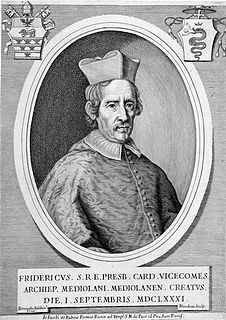
Federico Visconti (1617–1693) was an Italian Cardinal and Archbishop of Milan from 1681 to 1693.
Natalis was Archbishop of Milan in the mid-8th century. He is honoured as a saint in the Catholic Church and his feast day is May 13.
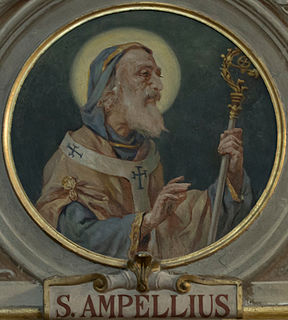
Ampelius was Archbishop of Milan from 671 to 676. He is honoured as a saint in the Catholic Church.


